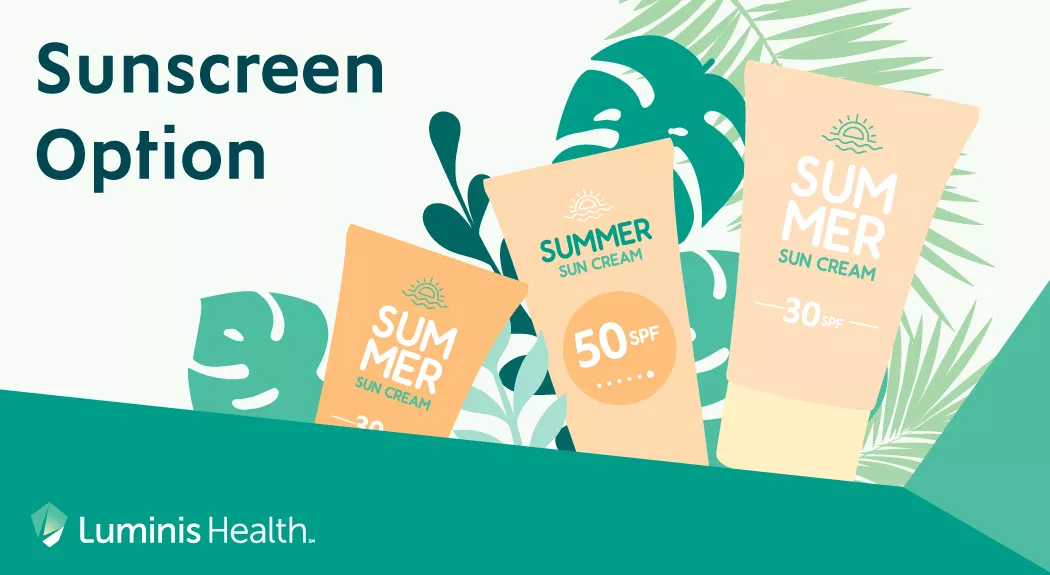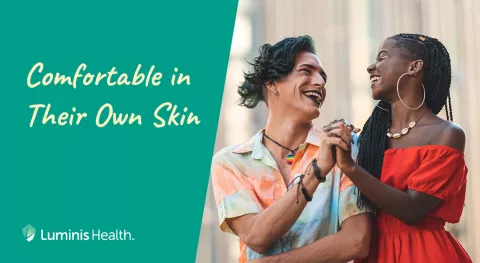
Protecting your skin from the sun with the right sunscreen is crucial. But picking the right sunscreen can be daunting. Knowing the basics before shopping can streamline your decision-making process, and hopefully prevent cancer.
Why sunscreen matters
One in five people will develop skin cancer in their lifetime — it is the most common cancer in the United States, and the most preventable. Your best defense is protecting your skin from the sun’s damaging UV rays. That’s why the American Cancer Society recommends a broad-spectrum sunscreen with SPF 30 or higher when outdoors.
Broad-spectrum sunscreens
The sun emits two types of rays: UVA and UVB, both capable of damaging the skin. UVB rays are responsible for sunburns and most skin cancers, directly damaging DNA in skin cells, prompting rapid growth and tumor formation.
In contrast, UVA rays accelerate skin cell aging, leading to long-term issues like wrinkles and rough skin. They can also indirectly harm skin cell DNA, contributing to certain skin cancers. A sunscreen labeled “broad-spectrum” is proven to shield the skin from both UVA and UVA rays.
Why use an SPF 30 or higher sunscreen?
SPF stands for sun protection factor—the sunscreen’s protection level against UVB rays. The higher the SPF number, the more protection you get. Here’s how SPF works: When using an SPF 30 sunscreen on your skin, for every 30 minutes you spend in the sun, you only get equal to 1 minute of UVB rays.
Here’s how much UVB rays each SPF filters:
- SPF 15 filters out about 93%
- SPF 30 filters out about 97%
- SPF 50 filters about 98%
- SPF 100 filters about 99%
SPF below 15 shields against sunburn but not against sun damage or cancer.. No sunscreen can filter or block all UV rays or protect you completely.
Chemical and mineral sunscreens: pros and cons
Sunscreens use either chemical or mineral ingredients, or a combination, to filter or block UV rays.
Chemical sunscreens use various chemical ingredients, including avobenzone, homosalate, and oxybenzone, to absorb UV rays before they can damage your skin.
- Pros: They are invisible once absorbed into your skin and feel comfortable.
- Cons: They can irritate sensitive skin, but need time to absorb before working.
Mineral-based sunscreens contain titanium dioxide and zinc oxide, creating a barrier on your skin’s surface that reflects UV rays.
- Pros: These work right away. They are safe for sensitive skin and are considered safe for coral reefs and marine life.
- Cons: They can feel thick or greasy and may leave a white residue on your skin, especially on darker skin.
What about water-resistant and tinted sunscreens?
Sunscreens can’t claim to be waterproof, they can only claim to be “water resistant” for 40 or 80 minutes. If you sweat a lot or spend time in the water, you may want to use water-resistant sunscreen.
Similarly, tinted sunscreens offers additional protection against visible light, benefiting individuals with hyperpigmentation disorders, commonly impacting.
How to apply sunscreen
Sunscreen only works if you use it correctly Maximize its effectiveness with these tips:
- Apply sunscreen at least 20 minutes before sun exposure.
- Use enough to cover exposed skin (if you can see light through your clothing, UV rays can reach that skin, too). Most adults must use one ounce of sunscreen, a shot glass, or a palm full
- Don’t forget your ears, both sides of your feet, and the back of your neck
- Reapply at least every two hours
- Apply again after swimming, sweating, or towel drying
One last tip- there’s no difference between baby and adult sunscreen. Both are safe to use. However, sunscreen is not recommended for babies under 6 months. If you have questions about your skin health, please contact Luminis Health Plastic Surgery for a consultation. Our experts can work with you to improve sun damage and protect your skin for years to come.
Telisha Johnson, NP, is a plastic surgery nurse practitioner at Luminis Health.



